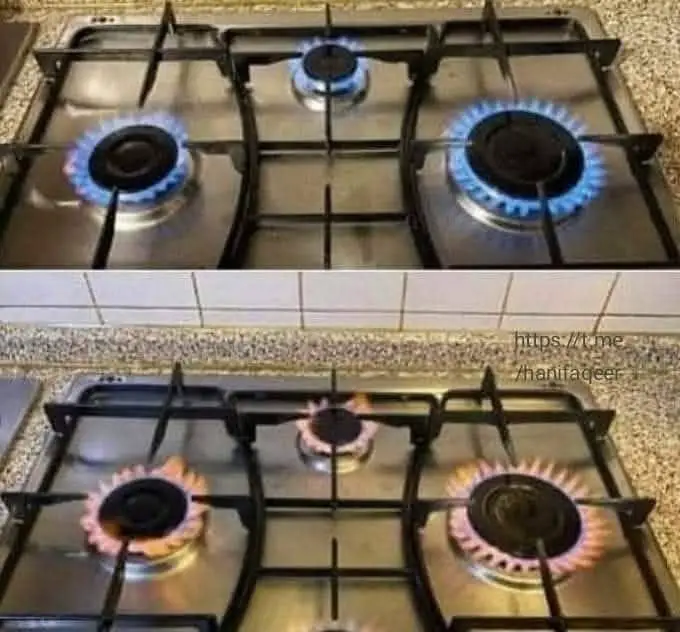Keep Your Stove Flame Blue: A Guide to Safe and Efficient Cooking
The color of your gas stove’s flame is a key indicator of its performance and safety. A blue flame signals efficient combustion, while red or orange flames point to problems that can waste gas, damage cookware, and release harmful gases. Here’s how to ensure your stove burns blue, plus FAQs and tips for safe, efficient cooking.
🛠️ Understanding Stove Flame Colors
- Blue Flame: Indicates complete combustion. Gas and oxygen mix properly, burning cleanly and efficiently. This saves fuel and heats cookware evenly.
-
Red or Orange Flame: Signals incomplete combustion, which can:
- Increase gas consumption.
- Blacken pots and pans with soot.
- Slow heating times.
- Release dangerous gases like carbon monoxide (CO).
Safety Note: If you see red or orange flames, open doors and windows immediately to ensure good ventilation and reduce the risk of CO buildup.
🔍 Causes of Incomplete Combustion
- Blocked Fuel Passages or Ventilation Systems: Dust, grease, or debris can clog burners or vents, disrupting airflow.
- Improperly Installed Stove: Misaligned burners or incorrect gas connections can lead to uneven burning.
- Dirty Gas Stove: Rust, soot, scale, or dust buildup prevents efficient combustion.
- Insufficient Cylinder Pressure: Low gas pressure (common in propane cylinders) can cause weak or uneven flames.
🛠️ How to Fix and Prevent Red/Orange Flames
-
Check and Clean Burners:
- Turn off the gas supply and let the stove cool.
- Remove burner grates and caps. Soak in warm, soapy water, then scrub with a non-abrasive sponge.
- Clear burner holes with a toothpick or compressed air to remove blockages.
- Tip: Clean burners monthly to prevent buildup.
-
Inspect Ventilation:
- Ensure stove vents and surrounding areas are free of grease or debris.
- Check that kitchen ventilation (range hood or windows) is adequate.
- Tip: Run your range hood or open a window while cooking to improve airflow.
-
Verify Installation:
- Ensure the stove is level and burners are properly seated.
- If using propane, check that the regulator and gas line are correctly installed.
- Tip: Consult a professional if you suspect installation issues.
-
Monitor Cylinder Pressure:
- For propane stoves, check the cylinder gauge (if available) or weigh the tank to ensure it’s not low.
- Replace or refill the cylinder if pressure is insufficient.
- Tip: Keep a spare cylinder to avoid interruptions.
-
Test the Flame:
- After cleaning or adjustments, light the burner and check for a steady blue flame.
- If the flame is still red/orange, contact a technician to inspect for gas leaks or burner damage.
❓ FAQs About Stove Flame Colors
Q: Why is my flame yellow instead of red/orange?
A: Yellow flames also indicate incomplete combustion, often due to similar issues (clogged burners, poor ventilation). Follow the same cleaning and inspection steps.
Q: Is a red/orange flame dangerous?
A: Yes, it can produce carbon monoxide, a colorless, odorless gas that’s harmful in enclosed spaces. Ventilate immediately and fix the issue.
Q: How often should I clean my gas stove?
A: Clean burners and grates monthly, and deep-clean the stove (including vents) every 3–6 months, depending on use.
Q: Can I fix low cylinder pressure myself?
A: Check connections and ensure the valve is fully open. If the problem persists, contact your gas supplier or a technician to inspect the cylinder or regulator.
Q: What if my stove is new but the flame is orange?
A: It may be improperly installed or adjusted. Contact the manufacturer or a professional to recalibrate the air shutter or check gas lines.
Q: How do I know if my kitchen has enough ventilation?
A: You should have a range hood, exhaust fan, or open windows. If you smell gas or feel dizzy while cooking, increase ventilation and check for issues.
💡 Tips for Safe and Efficient Cooking
- Clean Regularly: Wipe spills after each use to prevent grease buildup. Use a vinegar-soapy water mix for tough stains.
- Use a CO Detector: Install a carbon monoxide detector near your kitchen for added safety.
- Adjust Flame Size: Keep flames under the cookware base to avoid wasted gas and uneven heating.
- Check Gas Lines: Inspect hoses and connections yearly for leaks (use soapy water to spot bubbles).
- Ventilate Always: Open a window or use a range hood, especially with prolonged cooking.
- Schedule Maintenance: Have a professional service your stove annually to ensure optimal performance.
- Eco Tip: Pair this with other home hacks, like the DIY mosquito trap or pistachio shell powder, for a greener, safer home.
🌟 Why It Matters
A blue flame means your stove is running efficiently, saving gas, protecting your cookware, and keeping your kitchen safe. Red or orange flames are a warning sign—address them promptly to avoid health risks and costly inefficiencies. With simple maintenance and vigilance, you can keep your stove burning blue and your home a safe, welcoming space.
Friends raving about your mosquito-free patio or fragrant home? Add this stove maintenance hack to your arsenal for a fully optimized living space. Check out our pickled watermelon recipe or DIY fragrance guide for more ways to elevate your home! Share your stove care tips below! 🔥
Note: If you suspect a gas leak or persistent flame issues, turn off the gas supply and contact a professional immediately. Never ignore signs of carbon monoxide exposure (dizziness, nausea, headache).

